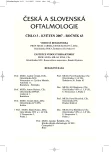The Contribution of the Hematological Examination in Patients with Retinal Vein Occlusio
Přínos hematologického vyšetření u pacientů s venózní retinální okluzí
Cíl práce:
Cílem sdělení je posoudit výsledky hematologického vyšetření u pacientů mladších 60-ti let po proběhlé centrální (CRVO )a větvové venózní retinální okluzi (BRVO) a prokázat eventuální přítomnost rizikových faktorů pro předčasný vznik aterosklerózy a rizikové faktory pro některá hematologická onemocnění.
Soubor a metodika:
Jedenáct pacientů (5 žen a 6 mužů), průměrný věk 38 let (mezi 15–56 lety). Osm pacientů s diagnózou CRVO a tři pacienti s diagnózou BRVO. Všichni pacienti podstoupili hematologické vyšetření. Sledovali jsme tyto hematologické parametry: přítomnost paraproteinu, hladinu homocysteinu, lipoprotein A, přítomnost antifosolipidových protilátek, hodnotu aktivovaného proteinu C rezistence, protein S, protein C, antitrombin III. Průměrná doba pozorování činila 19 měsíců.
Výsledky:
Hematologický screening byl pozitivní u pěti pacientů. Z tohoto počtu čtyři pacienti trpěli CRVO. Ve dvou případech byla zachycena hyperhomocystenémie, navíc u jednoho pacienta jsme zjistili zvýšenou hladinu antifosfolipidových protilátek. U dvou zbývajících pacientů byla zachycena vyšší hladina lipoproteinu A. BRVO jsme diagnostikovali v jednom případě. Výsledek hematologického vyšetření zde prokázal patologickou hodnotu aktivovaného proteinu C rezistence a nižší hodnotu proteinu S.
Závěr:
Na základě našich výsledků se domníváme, že výskyt více rizikových faktorů pro hematologická onemocnění zvyšuje pravděpodobnost vzniku venózní retinální okluze.
Klíčová slova:
centrální (CRVO) a větvová (BRVO) venózní retinální okluze, homocysteinemie, lipoprotein A, antifosfolipidové protilátky, aktivovaný protein C rezistence
Authors:
M. Kováčová; P. Pochop; I. Hochová 1; D. Dotřelová; D. Darsová
Authors‘ workplace:
Oční klinika dětí a dospělých UK 2. LF a FN Motol, Praha
přednostka doc. MUDr. D. Dotřelová, CSc.
; Oddělení klinické hematologie FN Motol, Praha
primářka MUDr. Ivana Hochová
1
Published in:
Čes. a slov. Oftal., 63, 2007, No. 3, p. 193-198
Overview
Objective:
The aim of this study is to evaluate outcomes of hematological examinations in patients under 60 years of age affected by central (CRVO) or branch (BRVO) retinal vein occlusion. Furthermore, it also proves possible existence of risk factors resulting in early atherosclerosis and hematological disease.
Patients and methods:
Eleven patients (5 women and 6 men) of 38 years of age in average (15–56 years) were examined. Eight patients suffered from CRVO, 3 patients from BRVO. All patients were tested for hematological diseases. We focused on the following hematological parameters: presence of paraprotein, homocysteine blood level, lipoprotein A, presence of antiphospholipid antibody, level of activated protein C resistance, protein S, protein C, antithrombin III. The average follow up period was 19 months.
Results:
hematological screening was positive in 5 patients, 4 patients out of them suffered from CRVO. High homocysteine blood level was detected in 2 patients and more over, an increased level of antiphospholipid antibodies was diagnosed in 1 patient. An increased level of lipoprotein A was determined in 2 remaining patients. BRVO was diagnosed in one case. Outcome of the hematological examination proved the pathological level of activated protein C resistance and lower level of protein S.
Conclusion:
according to these results we assume, the co-existence of more risk factors for hematological disease increase the probability of CRVO.
Key words:
central (CRVO) and branch (BRVO) retinal vein occlusion, homocysteine blood level, lipoprotein A, antiphospholipid antibody
Labels
OphthalmologyArticle was published in
Czech and Slovak Ophthalmology

2007 Issue 3
Most read in this issue
- Ocular Manifestations in Turner’s Syndrome
- The Methods of Analysis of the Endothelial Microscopy
- Comparison of the Two Methods, LASIK and ICL in Mild and High Hyperopia Correction – Part One
- The Contribution of the Hematological Examination in Patients with Retinal Vein Occlusio
